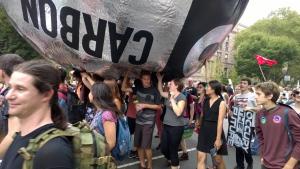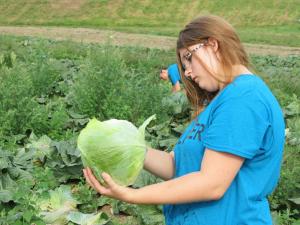Also of Note

“Experience showed that serious art-making and reflection on those processes engaged students, gave teachers new tools, transferred interest from one subject to another, enlivened the school day, and kept students in school,” said President Ellen McCulloch-Lovell. Ellen gave the keynote address at a summit titled “Envisioning Arts Education in Vermont,” hosted by the Vermont Arts Council (VAC) in September. Ellen related some of her own experiences proposing and promoting arts policy in Vermont and nationally, including founding the Governor’s Institutes, which began with the arts, and directing President Clinton’s Committee on the Arts and the Humanities.
Junior Edward Suprenant spent the summer in Nepal studying Buddhist philosophy at the Rangjung Yeshe Institute, through a partnership between Kathmandu University and the Tulku Urgyen monastery. “The focus of my stay was to hopefully loosen any myopic conceptions of Buddhism I may have gained through my previous studies,” says Edward, who studied Zen Buddhism at a monastery in San Francisco. “I got exposed to a lot of South Asian cultural aspects I wasn’t aware of. Being in that environment and studying the things that come from that social environment was really cool.”

“In the workplace, love can exist with those who are willing to lay aside ego, let their guard down, and explore their struggles together,” says Jodi Clark ’95, former director of housing. “With extra wisdom and trust brought to a particular problem, they may also discover that a powerful resource for fueling their work is their love and care for each other.” Jodi was the subject of a blog on JustMeans.com by Julie Fahnestock MBA ’14, titled “Is Love in the Workplace the New Norm?” .
Photography student Julian Harris ’14 had photos published in Living on Earth, Public Radio International’s environmental news magazine, in October. His striking images of traditional tanneries in Morocco were the result of a research project he did there during a program through the School for International Training (SIT), in collaboration with a fellow SIT student. The article focuses on the toxic chemicals used in traditional tanneries, which can result in serious health and environmental problems.
Hillary Boone MSM-MDO ’14, nonprofit programs communications coordinator, joined fellow Vermonters Senator Diane Snelling and Scott Johnson of the Lamoille Family Center at the RBA Africa Summit, held in Johannesburg, South Africa, in October. There, Hillary presented a session titled “Lessons Learned in Large Scale RBA (results-based accountability) Roll-out and Implementation.” In addition to handling communication for nonprofit programs at Marlboro, Hillary is program manager and RBA coach for Benchmarks for a Better Vermont, a federally funded initiative to integrate performance measurement systems in Vermont nonprofits.
 Claire Maleney ’15 (right) spent last spring semester in Switzerland, where she was studying with a School for International Training program titled International Studies and Multilateral Diplomacy. She focused on the International Criminal Court, but the highlight for her was traveling around Europe afterwards. “In many ways I think it has given me a clearer perspective on international relations,” she says, “and certainly a better understanding of how the history I’ve learned about plays out today.”
Claire Maleney ’15 (right) spent last spring semester in Switzerland, where she was studying with a School for International Training program titled International Studies and Multilateral Diplomacy. She focused on the International Criminal Court, but the highlight for her was traveling around Europe afterwards. “In many ways I think it has given me a clearer perspective on international relations,” she says, “and certainly a better understanding of how the history I’ve learned about plays out today.”
